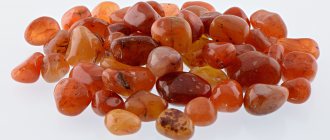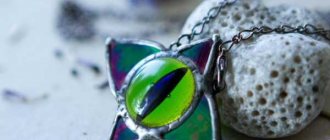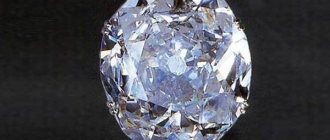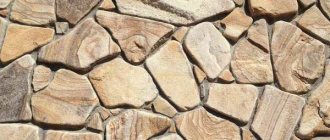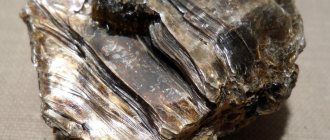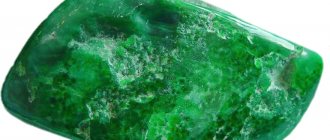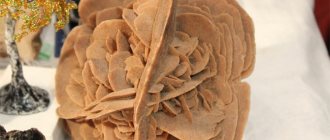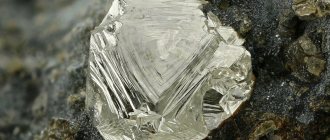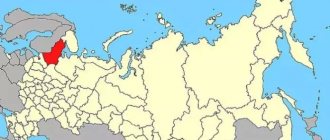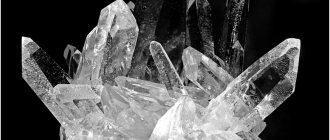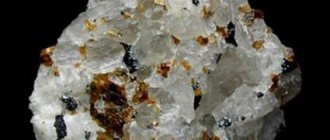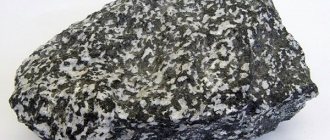History and origin
The history of man's use of stones of various types goes back thousands of years, because as soon as he began to recognize himself as a man, the need arose to build houses and roads, make dishes and jewelry. For this purpose, the hardest and most beautiful stones were used. One of these minerals was syenite - a massive, hard rock, similar in appearance to granite.
Mineral – Syenite
This stone began to be used in Ancient Greece. Near the city of Song, beautiful pinkish and gray stones were discovered that were perfect for building or lining houses and roads. C. Pliny then classified the mineral as a rock under the general name Siene. And several centuries after that, in Germany near the city of Dresden, G. Werner found similar stones and, based on ancient records and comparative analysis, gave it the name syenite.
In Russia, too, there are surprisingly interesting descriptions of syenite, left by Prince Kropotkin in the 19th century after a trip to Buryatia. He noticed that the mineral has a layered structure and alternates with granite.
Formation of the Syenites[edit]
Syenites are products of alkaline magmatic activity, usually forming in areas of thick continental crust or in Cordilleran subduction zones. To obtain syenite, it is necessary to melt a granitic or igneous protolith to a fairly low degree of partial melting. This is necessary because potassium is an incompatible element and tends to be the first to enter the melt, whereas a higher degree of partial melting releases more calcium and sodium, which produce plagioclase and hence granite, adamellite or tonalite.
At very low degrees of partial melting, a silica-undersaturated melt is formed to form nepheline syenite, in which orthoclase is replaced by feldspar such as leucite, nepheline or analcime.
Conversely, under certain conditions, large volumes of anorthite crystals can fall out of completely molten magma during the process of cumulation as it cools. This leads to a sharp decrease in the silica concentration in the rest of the melt. Separating the silica from the melt leaves it in a state that can promote the formation of syenite.
Mineral mining
Syenite is often a companion of granite, and therefore it is usually found near its deposits - in the marginal zone - in the form of massifs and veins. The stone is classified as an igneous rock located deep underground, although, thanks to the ongoing internal life of the planet, it is now often found on the surface.
This breed is one of the most common on Earth and is found everywhere. Large deposits are located in North America (Arkansas and Wisconsin), Africa (South Africa, Kenya, Uganda), Brazil, Germany and the islands of Scandinavia.
In Russia, syenite deposits were discovered in the Trans-Baikal Territory, on the Yenisei Ridge and the Kola Peninsula. And in the Sayan Mountains there is a nature reserve called Krasnoyarsk Pillars. There, bizarrely shaped columns form an unearthly landscape. They are oddly shaped blocks stacked on top of each other.
Links[edit]
- Sorensen, H. 1974. Alkaline rocks. 1st edition. John Wiley & Sons Ltd. 634 pp. ISBN 0-471-81383-4.
- Streckeisen, A.L. 1978. IUGS Subcommittee on Igneous Rock Taxonomy. Classification and nomenclature of volcanic rocks, lamprophyres, carbonatites and melilite rocks. Recommendations and suggestions. Neues Jahrbuch für Mineralogie, Abhandlungen, 141, 1–14.
- Motoki, A., Sichel, S.E., Vargas, T., Ayres, J.R., Ivanuch, V., Mello, S.L.M., Motoki, K.F., Silva, S., Balman, A., Goncalves, J. 2010. Geochemical evolution of felsic alkaline rocks of the Tangua, Rio Bonito and Itauna intrusive bodies, State of Rio de Janeiro, Brazil. Geociências, Rio Claro, 29–3, 291–310.
- Motoki, A., Araujo, A.L., Sichel, S.E., Motoki, K.F., Silva, S. Differentiation process of nepheline syenite magma by assimilation of continental crust for the Cabo Frio Island intrusive complex, Rio State de Janeiro, Brazil. Geociências, Rio Claro, 2011, in press.
Attribution
- This article incorporates text from a publication now in the public domain: John Smith Flett (1911). "Nepheline-syenite". In Chisholm, Hugh (ed.). Encyclopedia Britannica
(11th ed.). Cambridge University Press.
Physicochemical characteristics
Syenite, an intrusive holocrystalline rock, was formed as a result of volcanic activity that continued on Earth for many thousands of years. The movement of magma and its constant replenishment with new minerals formed the interesting structure of the stone - a combination of small and large mineral grains of different colors - pink, gray, green and dark.
The rock is most often formed by feldspar, dark-colored minerals and silica. And the concentration of acidic minerals makes syenite an alkaline rock.
Also read: Cat's eye - magical light inside the crystal
| Property | Description |
| Hardness | 6 |
| Density | 2600 kg/m³ |
| Strength | 150-300 MPa |
| Brightness | 86% |
| Texture | Massive |
| Structure | Full-crystalline, uniformly crystalline, sometimes porphyritic, fine- and medium-grained |
| Mixing | Feldspar and dark-colored minerals |
| Form of occurrence | Dykes and rods |
| Genesis | Intrusive |
| Color | Light-colored rocks, grayish and pinkish, depending on the color of potassium feldspar and the content of dark-colored minerals |
Average chemical composition:
- SiO2 56-62%,
- TiO2 0.5-2%,
- Al2O3 14-19%,
- Fe2O3 1-4%,
- FeO 0.5-5%,
- MgO 0.2-3%,
- CaO 1-5.5%,
- Na2O 4-6.5%,
- K2O 4-9%.
Geologists often call the stone quartz-free granite due to the absence of the radiant mineral in its composition. This feature deprives the stone of its shine.
In general, syenite is very similar to granite, but it is more susceptible to weathering and has a lower strength level.
Taxonomy
Nepheline syenite is an intrusive rock. Its systematic characteristics are as follows:
- Class – plutonic rocks;
- Order – rocks of medium composition (silicic acid content from 52 to 63%);
- Suborder – moderately alkaline rocks;
- Family – syenites;
- The type of rock is syenite.
The adjective “nepheline” indicates a rock-forming mineral. Syenites can also be enstatite, hornblende, and so on.
Types of stone
Depending on the mineralogical composition, syenites are divided into types:
- Syenodierites (Diorites) are greenish-gray, medium-grained, speckled structure, in which all minerals are clearly visible: magnetite, ilmenite, apatite, common hornblende. This massive stone is used in construction due to its characteristics: high hardness, non-fragility, strength (it can only be cut with a diamond).
- Monzonites (Gabbro) are black, dark green, spotted, smooth, evenly granular in structure, rich in plagioclase, quartz, chromite and apatite. Gabbro is similar to diorite, but has a dark color. Used for the production of high-strength facing and building stones.
- Syenite - porphyry - gray, brown, containing large spar crystals, with a trachyte structure.
- Nepheline syenites are white, grayish, reddish and greenish, closely resembling granite with many components: potassium feldspar, granular nepheline, titanium, enigmatite, chlorine, fluorine, phosphorus and non-ferrous metals that determine the color of the stone. It is an alkaline intrusive rock.
The complex fluctuating composition of nepheline syenite determined the appearance of several types of this mineral:
- Khibinites. They occur in the Khibiny Mountains and have a complex coarse-grained structure.
Khibinit - Foyaites. A breed with large grains on a light gray background.
Foyait - Miaskites. A mineral with a wide range of colors: from gray to pink and dark gray. It contains zircon, corundum and garnets, which gives the impression that shine emanates through the thickness of the stone.
Miaskit - Rischorrites. Thanks to biotite, the stones have a noble color: from deep green to gray ocher.
- Luyavrites. Due to its oversaturation with alkalis, it has a black-green color and a banded structure.
Luyavrit
When weathered, nepheline syenite acquires a blue glow.
Composition of the Syenites [edit]
The feldspar component of syenite is predominantly alkaline in nature (usually orthoclase). Plagioclase feldspars may be present in small quantities, less than 10%. Such feldspars are often interbedded as perthitic components of the rock.
When ferromagnesian minerals are present at all in syenite, they usually occur in the form of hornblende, amphibole, and clinopyroxene. Biotite is rare because in syenite magma, feldspar formation consumes almost all the aluminum, however fewer aluminum-rich phyllosilicates, such as annite, may be included.
Other common accessory minerals are apatite, titanite, zircon and opaques.
Most syenites are either alkaline with a high content of alkaline elements compared to aluminum, or high-alumina with a higher concentration of aluminum compared to alkali and alkaline earth elements (mainly K, Na, Ca).
Scope of application of the mineral
All types of syenite are in demand by people in different areas of life, because the cost of processing them is minimal.
- Nepheline syenite, which in geology belongs to the group of framework silicates, is used
- Construction : as crushed stone for paths and areas near houses, internal and external cladding of houses, plinths, balconies, floors; in the production of anti-corrosion coatings for reinforced concrete structures.
- Chemical industry : in the production of cement, soda, alkali, glue, gels, paper and leather. Since the 30s of the 20th century, it has been widely used as a raw material for the production of alumina, necessary in the production of aluminum. It is classified as non-waste, because by-products: soda and sludge are used in the production of cement and silicate products, in the glass and ceramic industries. Modern technology makes it possible to simultaneously isolate rare chemical elements: gallium, rubidium and cesium.
- Agriculture : as part of highly effective fertilizers for acidic soils. Such fertilizers are created on the basis of potassium and without chlorine. They are absolutely harmless to soil, plants and humans. They reduce acidity, displace potassium and create conditions for plants to quickly absorb nutrients.
- Decorative purposes : for making sculptures, decorating fountains, stairs, making boxes, photo frames, writing sets
- Diorite, due to its color and structure, is used for the production of tabletops, pedestals, sculptures, steles, and monuments.
- Gabbro is used in construction in the form of stone tiles, crushed stone, chips, high-strength facing material, as a raw material for stone casting and in the production of mineral wool.
- Porphyry is one of the most durable rocks. They are a quarter harder than granite. This quality is used in construction and cladding. Cladding tiles or paving stones made from porphyry last 14-15 years, which is twice as long as granite tiles. Due to its high wear resistance, it is not afraid of impacts, sharp heels and scratches. And its low thermal conductivity makes it an excellent thermal insulation finishing natural material. Porphyry has the amazing property of self-cleaning. It allows the use of this mineral as a floor covering in factories and gas stations, in auto repair shops and car dealerships, where floor contamination with difficult-to-remove substances of oil origin is inevitable. The spots will disappear in 2-3 weeks. The production of facing slabs does not require additional processing, since the cut stone has a pattern created by nature itself.
Nepheline Syenite
The use of porphyry for decorative purposes is due to the natural beauty of the pattern and is used in the decoration of ceilings and swimming pools. Ceiling tiles made from this mineral can create the effect of ancient Roman buildings. The stone is beautifully painted, taking on any color.
Episyenitis [edit]
Episyenitis
(or
epi-syenite
) is a term used in petrology to describe the depletion of silica (SiO 2 ) in a silica-rich rock. [6]
The process that leads to wasting is often called episenitization
. The term refers only to the macroscopic effect of relative rock depletion; it says nothing about the nature of the physical processes leading to exhaustion in any particular case. Many different metamorphic processes can lead to epienitization. For example:
- Chemical components in a stagnant melt can diffuse under the influence of chemical potential gradients, which cause them to segregate from low-SiO 2 components as the melt begins to solidify.
- The SiO 2 -unsaturated fluid can dissolve quartz from the rock and remove it by advection, leaving the source rock depleted in silica.
- A slightly molten rock mass can retain unmolten silica-rich components while the molten, silica-depleted liquid cools to form syenite.
- When cooled, the fully molten silica-rich melt can precipitate its silica-containing components, causing the silica-depleted melt to subsequently form syenite.
Medicinal properties
Syenite is a product of the planet’s volcanic activity, which has accumulated earthly energy over millions of years. He is able to carry out constant energy exchange with a person. This helps to harmonize your internal state and establish peace of mind and balance.
The stone is widely used in Chinese and Tibetan medicine as a biostimulator on biologically active points of the body. And in Indian Ayurveda, small, smooth, round-shaped syenites relieve pain of various natures and localizations.
The stone has also found its use in traditional medicine. Polished gabbro is used during massage procedures. In spa salons, massage with a mineral heated to room temperature has a relaxing and restorative effect.
In folk medicine, it is believed that yellow and gray nepheline syenites have a beneficial effect on the gastrointestinal tract and increase appetite, while green and gray ones normalize the functioning of the nervous system and improve vision.
Magic properties
The stone is widely used in clairvoyance and extrasensory perception as a talisman. It reveals talent, increases abilities, helps expand the boundaries of the world around us, is effective in the hands of students, as it is able to help everyone who is drawn to something new, to discoveries, to knowledge of the Universe and its laws.
As an amulet, the mineral is protection against rash actions and hostile actions from the outside. Many astrologers claim that for Taurus and Aries, a small syenite placed above the entrance to the house will protect them from the evil eye and bad thoughts and create an atmosphere of love and prosperity.
Interesting things about the stone
- The world-famous sphinxes on the University Embankment in St. Petersburg are carved from syenite and are about three and a half thousand years old.
- Krasnoyarsk pillars made of pink syenite “grew” on the body of a huge monolith. Many millions of years ago, during violent magmatic activity, molten magma was able to break through cracks in it and froze on the surface, forming a magical picture.
Syenite cannot be classified as a precious stone. It is not used in expensive jewelry. But its value lies elsewhere: it was and will remain a symbol of the eternity and inviolability of Nature, reminiscent of the fragility and insecurity of man.
5/5 — (1 vote)
Notes[edit]
- Kresten, Peter; Troll, Valentin R. (2018). "Alnö Carbonatite Complex, Central Sweden". GeoGuide
. DOI: 10.1007/978-3-319-90224-1. ISSN 2364-6497. - S. W. Wallace (1953). Petrology of the Judith Mountains, Fergus County, Montana (Report). US Geological Survey.
- Jump up
↑ Sutherland, D.S. (ed.) (1982)
Igneous Rocks of the British Isles
, page 211 - Eby, GN, 2012, The Beemerville Alkaline Complex, Northern New Jersey, in
Harper, JA, ed., A Journey through the Taconic Unconformity, Northeastern Pennsylvania, New Jersey, and Southeastern New York:. Manual, Seventy-seventh Annual Field Conference of Pennsylvania Geologists, Shawnee on Delaware, PA, p. 85–91.
